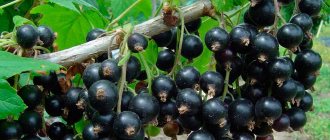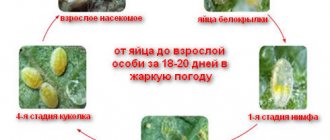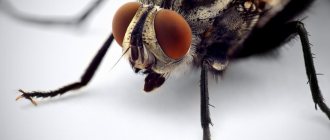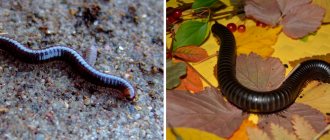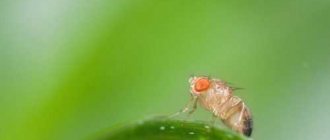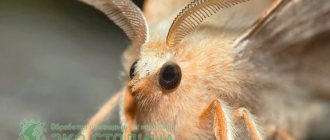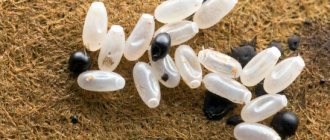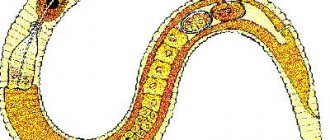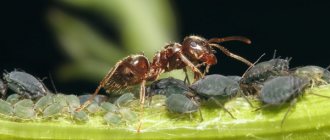Gooseberries and currants – popular crops in gardening. They do not require careful care, watering and fertilizing, but they bring a rich harvest. Plant diseases and pests can rob a gardener of his juicy berries. After all, gooseberries and currants themselves are helpless against them. For example, the gooseberry moth, which inhabits almost the entire territory of Russia, causes significant damage to berry crops. The larvae of this butterfly can eat up to 15 berries at a time. Therefore, experts advise fighting this pest and following the rules of prevention so that it does not disturb berry crops again.
Characteristics of the fire
The gooseberry moth is a subspecies of the scalywing moth, which belongs to the butterfly family. It is small in size and dark brown in color. The bug lays its eggs in the buds and ovaries of gooseberries, raspberries and currants. Just one individual moth is capable of producing 100-150 eggs.
After ten days, caterpillars hatch from the eggs. In a berry that is already ripe by that time, one caterpillar attaches itself, and its sisters and brothers crawl into neighboring buds in search of food. Moth caterpillars eat only the contents of fruits and their seeds, leaving biological waste inside. Of course, this causes the berries to deteriorate and rot.
When the caterpillar eats one berry, it crawls into another. About a month after their birth, the caterpillars descend along the web into the ground to pupate there, overwinter and fly out of the ground in the spring to reproduce. Typically, moth pupae overwinter at a depth of up to 7 centimeters in the soil next to bushes.
Adult moths fly for about a month. At the end of this period, the berry crops are just blooming, which is attacked by insects.
Signs of infection
It is not difficult to detect the moth on a gooseberry - to do this you just need to inspect the bush and the fruits. When infected, small holes will be visible on the berries through which the finest threads of cobwebs stretch. Over time, the number of such fruits will increase significantly.
On a note! Moreover, a lump of cobwebs around them will also grow, and often in one such cocoon you can find several berries of varying degrees of ripeness and contamination at once - some can be absolutely fresh, others can be rotten and dried out.
The main source of food for gooseberry moth larvae is fruit pulp and seeds. Moreover, while damaging the internal tissues of the fruit, the caterpillars will not touch the peel. And if you try to stir up a ball of tangled berries and crush the healthiest looking one, you will probably find a bright green caterpillar with a black head inside.
If you do not destroy the pest population in time, then after a short period of time most of the berries will be in the web and the entire harvest will be under serious threat. And the caterpillars, having gained enough strength, will descend into the soil and calmly go to winter.
What measures exist to combat the moth. What are the rules of prevention?
There are many different ways to directly combat the moth. If they are consumed in time, the insect will not have time to destroy the crop. Each method is used depending on the period and stage of development of berry crops:
- Agrotechnical - from the beginning of spring until the very end of autumn.
- Treatment with poison - from the beginning of spring until the beginning of flowering, at the end of summer and in the fall, when the harvest is harvested.
- Spraying with biological agents - throughout the entire growth and development of bushes.
- Folk methods - throughout the entire period of development.
Agrotechnical methods against moth
Obviously, weakened bushes will suffer more from pests than stronger ones. Therefore, it is necessary to follow the usual agrotechnical rules so that gooseberries and currants develop normally and grow well:
- thin out bushes as necessary;
- do not fertilize excessively;
- clean the roots of the bush from fallen leaves;
- cut off shoots;
- treat against pests and diseases;
- dig up soil within the radius of the trunk;
- Hill up and cover the soil next to the bush for the winter.
Digging the soil
Adult moth caterpillars directly descend to the soil surface to burrow into it and modify into a pupa. If at the end of autumn you dig up the first layer of soil within a radius of up to 50 centimeters from the bush, the pupae that fall out of the ground in winter will simply freeze and die.
It should be remembered that the roots of currants and gooseberries are not deep, so you need to dig up the soil carefully and no deeper than 5 centimeters.
Hilling
Usually the pupae spend the winter closer to the center of the bush. To prevent insects from attacking gooseberries or currants in the summer season, they need to be directly earthed up in the autumn. As a rule, this procedure is carried out in late September - early October. In the root circle, the soil is loosened and a mound is poured into the base of the bush, the height of which should be approximately 10 centimeters. When the butterfly hatches from the cocoon in the spring, it will be difficult for it to crawl through the layer of soil and it will not be able to lay eggs.
Ground cover
Covering the soil with dense material is called mulching. First, a peat or compost layer is laid out near the base of the bush within a radius of 30-40 centimeters and a thickness of 10 centimeters. This is done as soon as the snow melts so that the butterflies cannot leave their hibernation site. The poured layer is removed when the berries are completely ripe.
Also in early spring you can cover the soil next to the bush with dense roofing felt. For butterflies, it will become a wall through which they are unlikely to crawl.
Mechanical collection of affected berries
If there are few affected berries on the bush, you can use mechanical picking. All berries that will be collected must be poured with boiling water and disposed of. This will help protect the rest of the crop from moths at the very beginning of infection of the bushes.
Thinning bushes
A heavily thickened bush directly creates favorable conditions for the life of moths. If you trim the bush in time, this will improve air circulation and light in it. In addition, if you thin out the bushes every year, larger fruits will grow on them.
Moth traps
Everyone knows that all butterflies fly towards the light. Fireweeds are no exception here. You can buy a light “trap” in a specialized store, or you can make it yourself. To do this, take an ordinary light bulb, connect it to electricity and turn it on at night. Next, the light bulb is covered with a glass cap, which is pre-coated with something sweet and sticky. The fireflies fly towards the light and sweet smell, land on the cap and fall into the trap.
Helpful Tips and Mistakes to Avoid
Experienced gardeners share tips for combating moth:
- To reliably protect gooseberries from wax moths, it is also worth treating neighboring plants (currants, raspberries) that are susceptible to damage by these insects.
- Since the life cycle of the pest is 40 days, and the insecticidal preparations used to destroy it last no more than 20 days, the procedure for spraying gooseberries with chemicals is carried out 2-3 times.
- For treatment with insecticides to be highly effective, an integrated approach is needed, including parallel control of pupae located in the soil. To do this, use systemic agents (“Confidor maxi”, “Aktaru” and others), diluting the drug in water (8 g per 10 l) and watering the soil around the roots with the solution.
- Using an adhesive, for example, grated and dissolved laundry soap in water, when spraying will help the active substances remain on the leaves of the plant for a long time and act more effectively.
It is better to avoid the use of insecticidal preparations (systemic and contact) at air temperatures above +25°C, since in the heat their phytotoxicity increases, which leads to a negative effect on the human body.
Traditional methods
Gardeners have already accumulated a wealth of experience in the prevention and control of gooseberry moths. Basically, all products have an unpleasant odor for insects and repel them, and some reduce their activity and irritate the upper layer of the skin of larvae and moths.
Tar and turpentine
Turpentine and tar are good at repelling insect pests. To protect the bushes from moths, you need to pour these liquids into different jars and place them next to the bushes.
Chamomile
From the beginning of flowering, you can treat all currant and gooseberry bushes with an infusion of chamomile. To prepare it, you will need to pour 100 grams of dry chamomile into a bucket of hot water and infuse the resulting solution. Next, it is filtered, poured into a sprayer and sprayed on the bushes in the early morning and late evening.
Persian chamomile
Persian chamomile or feverfew powder has the properties of tansy. It directly contains a strong toxin that negatively affects the nervous system of insects. This powder is used to pollinate bushes to kill caterpillars and moths.
You can also plant tansy itself near berry bushes. 1 tansy flower is enough for 5 gooseberry bushes. The insect does not like its smell and reduces its activity.
Ash
An alkaline solution is prepared from the ash to treat the bushes. To do this, you need to pour ⅓ of the ash into a bucket and fill it with water to the top. Next, the composition is infused for 48 hours and filtered.
Mustard
Mustard contains essential oils and alkaloids that help cope with moth. To spray the bushes, prepare a solution from mustard powder: 10 tablespoons of dry mustard are poured into a bucket of running water and left for 2 days. Next, you can add a little liquid soap so that the composition sticks to the leaves better. The resulting mass is diluted with water in a proportion of ½ and the bushes are treated with it.
Sagebrush
The bitter smell of wormwood always repels moths. An infusion is prepared from it for treating bushes: 7 tablespoons of wormwood are poured into 1 liter of water, allowed to brew for 60 minutes, and then filtered and diluted with 10 liters of water.
You can also stick a dried wormwood branch into the middle of the bush. This will also repel insects.
Tobacco
Tobacco contains nicotine, which kills moths. Bushes are treated with its infusion 7 days after flowering. To prepare the solution, pour 200 g of tobacco into a container, add 3 liters of hot water, close tightly and leave for 48 hours. Before the procedure, liquid or solid soap (grated) is added to the composition.
Vinegar
Vapors from vinegar essence irritate the respiratory tract of caterpillars and butterflies, and also irritate their delicate skin. Therefore, after treatment, insects die immediately.
To prepare a working solution, 250 milliliters of 9% vinegar are diluted in 10 liters of water. The resulting product is sprayed onto the bushes immediately after flowering.
Which plants are at risk?
As is clear from the name of the insect, the gooseberry moth loves gooseberries.
However, sometimes it can feed on currant and raspberry berries. Insects always gnaw through the ovaries from the outside and eat away the seeds and pulp of the berries. This insect is not afraid of other garden and vegetable crops.
Interestingly, the moth is still considered the only creature on the planet capable of completely digesting wax. She succeeds in this thanks to special enzymes that are found in her saliva.
Pesticide
Chemicals help eliminate the moth quickly. Unfortunately, they directly harm not only the insect, but also the berry crop itself, as well as the animals living nearby. It is advisable to use pesticides when neither traditional nor agricultural methods help.
Typically, insecticide treatment is carried out early in the morning or late in the evening. There should be no rain, hail or wind.
One and a half to two liters of poison solution is usually enough for a whole bush. And if biological products are used in processing, then they need from two to five liters per bush.
First, the bushes are sprayed with pesticides. Their effect lasts for 1-2 weeks. Next, the treatment is completed with biological preparations. This is repeated until all caterpillars and butterflies are directly destroyed.
Before flowering begins
Before the flowers appear, the bushes are treated with the following preparations:
- “Fofanon” (3 ml per bucket of water),
- “Inta-Ts-M” (1 tablet per 10 liters of water),
- “Actellik” (2 ml per 2 liters of water).
The active ingredients of the drugs have a detrimental effect on the digestive, respiratory and nervous systems of moths and paralyze them. Insects die from poison very quickly - from 2 to 24 hours. In this case, not only the larvae are destroyed, but also the moth eggs and their adults.
During flowering
As soon as the buds on the bushes begin to open, the plants must be treated with the following means:
- “Bitoxibacillin” (100 grams per bucket of water),
- “Fitoverm” (1.5 milliliters per liter of water),
- “Lepidocide” (30 grams per 10 liters of water).
All these drugs enter the caterpillar's intestines and have a detrimental effect on it. Soon (after about 48 hours) the insect dies.
During the ripening period of berries
During the ripening of berries, currant and gooseberry bushes can be sprayed with the same preparations that are used for treatment during flowering (“Fitoverm”, “Bitoxibacillin”, “Lepidocid”).
The treatment procedure is carried out approximately once a week. However, it is important to remember that processing is stopped 5 days before picking the berries.
It is also important to know that the above products have a very unpleasant odor, which can smell like berries. After collection, they are thoroughly washed up to 3 times.
What happens if you don't fight the pest?
If you do not pay attention to the condition of the gooseberry bushes and do not take measures to destroy pests, the moth population quickly increases and, as a result, you can lose the entire crop. Feeding on berries, the caterpillars gain strength, after which they go into the soil under the plant, pupate, and in the spring of next year the butterflies, the number of which has increased hundreds of times, lay eggs and destroy flowers, ovaries, leaves and fruits. If you do not respond properly, the affected area will increase every year and capture new plants.
Preventive measures
In order to directly protect currant, gooseberry and raspberry bushes from insect pests, it is necessary to carry out preventive measures from the beginning of the spring to the end of the autumn seasons:
- Before flowering , cover the soil in the tree trunk circle with mulching material. This will prevent the bugs from crawling out of the ground after wintering.
- In the summer - treatment of bushes for preventive purposes, mechanical (manual) collection of damaged berries and cocoons with cobwebs on them.
- In the autumn , dig up the soil and hill up the bush to prevent pests from overwintering and crawling out of the ground.
- When planting shrubs, leave at least one meter between bushes. Otherwise, in a heavily dense planting, it will be very difficult to cope with butterflies.
- Regular pruning and thinning throughout the growing season.
It is also important to know that the resistance of berry crops to pests depends on their variety, weather conditions, the presence of diseases, temperature and air humidity.
If spring is quite warm and started early, the moth attacks early varieties of currants and gooseberries. But if spring started late and is quite cold, the moth prefers to directly attack later varieties of berry crops.
Causes
Reasons for the appearance of moth on gooseberries:
- the presence of a pest on currant or raspberry bushes growing nearby;
- dense plantings and irregular pruning of branches, which leads to a lack of lighting and air;
- lack of proper care of the garden plot (cleaning up fallen leaves, fruits and other plant debris);
- non-compliance with the rules of agricultural technology (timely loosening and digging of the soil, mulching);
- neglect of preventive treatment measures to prevent plant damage.
Cone moth
Cone fire.
The pest destroys coniferous trees. The larvae of the cone moth eat young shoots, which helps slow down the growth of the young plant and development. Infected needles dry out and the cones fall off. The cones have eaten away scales. The larvae mainly feed on pine, larch, fir, and cedar pine.
The small butterfly has an oblong body and a cone-shaped head. The hind wings are whitish-gray. The front wings are gray in color and have a dark border. The pupa barely reaches 10 mm. It has a light brown or dark brown color.
Life cycle
- During the mating period, females lay up to 5 eggs.
- The eggs are yellowish-red in color.
- After 2 weeks, large, reddish-brown larvae appear, with dark stripes on the side. They eat the scales and shoots without affecting the stem.
- Having absorbed nutrients, the pupation stage begins.
- Overwintering occurs in a web cocoon.
Fighting methods
Methods include:
- spraying with chemicals;
- tree pruning;
- a work of deep digging.
The drugs “BI-58” and “Rogor-S” are also used. They spray the crowns of conifers.
Expert opinion
Evgeniy Koshalev
I dig in the garden at the dacha until the last rays of sunshine every day. No specialty, just an amateur with experience.
It is very economical to handle landings from helicopters that are suffering from mass destruction. 300 liters of composition are required for 1 hectare. The processing is done once.
Spreading
The gooseberry moth lives where there are forest-steppe and steppe zones. This is the entire territory of Europe, as well as the North American continent. According to the observations of scientists, there are regions in which this pest rampages most often. Russian gardens located in the following areas will suffer the most from the moth:
- Moscow;
- Ryazan;
- Ivanovskaya;
- Vladimirskaya;
- Tverskaya.
However, this does not at all indicate that other regions need not be afraid of the pest. It lives and multiplies in Eastern and Western Europe, which means it is found everywhere, including Karelia and Siberia.
conclusions
- Moth and glass beetle are one of the most dangerous pests of currants. The pest needs to be controlled from early spring to late autumn.
- As soon as the snow melts, you can put a piece of roofing felt under the bush to prevent the butterflies from flying out.
- In the spring, spraying solutions prepared according to folk recipes will help scare off butterflies.
- In the summer, you need to carefully inspect the bushes and pick off all suspicious bunches of berries. They need to be scalded with boiling water.
- During the ripening period, to combat caterpillars, it is allowed to spray the bush with biological products. After picking the berries, pesticides can be used for treatment.
- In late autumn, you need to hill the bush to a height of 10 cm to make it difficult for butterflies to emerge from the ground.
- Elderberry bushes planted near currants will repel the moth from it.
What does it look like
The gooseberry moth is a small gray butterfly with a wingspan of up to 0.3 cm. The front pair is gray with brown stripes and white scales, and the back pair is much lighter than the front and has a black edge.
The caterpillars of the pest are somewhat smaller and reach a length of about 1.2-1.4 cm. The caterpillar has a light body, on which dark blurry stripes are clearly visible.
The anal and pectoral shields are brown, and the head is black. The brown pupa of the pest reaches 9 mm in length and has 8 curved spines on the cremaster.
She spends the entire winter in the very top layer of soil, and with the arrival of spring and the appearance of buds on gooseberries and currants, butterflies appear from the cocoons.
Currant varieties resistant to the pest
There are no currant varieties resistant to moth and scale insects. Bushes that have strong immunity to disease have a better chance of recovering faster after an encounter with a pest if they receive timely help.
The stability of currants depends on many factors:
- Genetic origin;
- Degree of adaptation to climatic conditions;
- Weather conditions during the growing season;
- Degrees of adaptation to diseases and pests.
In early warm spring, early varieties of currants suffer more from the moth. If spring is prolonged, harmful butterflies will lay more eggs in flowers of late varieties.
Table: Recommended blackcurrant varieties
| Name | According to ripening period | Berry weight, g | Taste rating, point |
| Pearl | early | 4 | 5 |
| Crane | average | 1,5 | 4 |
| Minay Shmyrev | average | 1 | 4,3 |
| Ant | average | 1,1 | 4 |
| Lazy person | late | 2 | 4,8 |
| Chereshneva | late | 3 | 4 |
To develop new resistant forms of red currant, hybrids obtained by crossing the varieties Chulkovskaya, Rote Spätlese, Maarsea Prominent, Jonker van Tets are used.
Table: Recommended varieties of red currants
| Name | According to ripening period | Berry weight, g | Taste rating, point |
| Gazelle | early | 0,5 | 3,5 |
| Alpha | average | 1,5 | 4,7 |
| Red Andreichenko | average | 0,7 | 4,2 |
| Dutch red | late | 1 | 3,5 |
| Gift of summer | late | 0,9 | 3,5 |
Description of wax moth
Name: Moths Lat.:
PyralidaeClass: Insects - Insecta Order: Lepidoptera - Lepidoptera Family: Moths - Pyralidae
| Habitats: | garden and vegetable garden, forest, plantings |
| Dangerous for: | many green spaces |
| Means of destruction: | chemicals, traditional methods |
Wax moth moth.
There are 2 types of moths. The first variety includes the large waxy one. Its dimensions range from 3.5 to 3.8 cm. Moths - the second type (small bees) barely reach 2.4 cm.
The front wings are small gray-brown in color. The larger variety is distinguished by brownish-gray or brownish-yellow wings. The hind wings are cream in color in large individuals and silvery-white in small ones.
The butterfly lays white eggs. One clutch contains about 300 pieces. Their development occurs in 5–10 days. The size of the newly hatched larva is up to 1 mm.
The caterpillar measures 1.6 cm - 3.5 cm. The pupation period ranges from 25 to 30 days. The lifespan of an adult female is from 7 to 12 days and that of a male is from 10 to 26 days.
What is the harm from moth in the hive?
Caterpillars inhabit bee hives. They initially consume honey and bee bread. Then they begin to feed on wax honeycombs. Caterpillars form tunnels and move along them, defecating and secreting thin cobwebs. The web seals the honeycomb, preventing the bees from depositing honey.
The caterpillars eat each other, as well as the droppings of the previous generation. This leads to severe infection. 1 pest destroys about half a thousand cells.
Large numbers form a web, which denies access to honeycombs, and the bees begin to weaken. In some cases they die or fly away from the hive.
Methods for killing bee moths
There are a number of methods that allow you to remove moths from hives and protect the bees. Some are gentle, while others are quite extreme.
Expert opinion
Evgeniy Koshalev
I dig in the garden at the dacha until the last rays of sunshine every day. No specialty, just an amateur with experience.
I divide them into folk and special. Each one is tested and effective.
Safe traditional methods
| Mechanical | Honeycombs containing the pest must be carefully removed by tapping. Pests fall off and need to be collected and destroyed. |
| Vinegar | The moistened cloth or cotton wool is placed on the honeycomb and wrapped in film. The effect will be in 3 days, but will have to be repeated. |
| Temperature | You can freeze the honeycombs for 2 hours at a temperature of -10 degrees or more. If you take a high one - +50 minimum. |
| Naphthalene | An unpleasant odor repels moths, just like any other moth. Bees are not affected by the scent. It's better to start in the spring. |
| Combustible sulfur | Fumigation with sulfur should be carried out every 10-14 days to destroy all pests. Be sure to ventilate the honeycombs. |
Special preparations
Two different means of action are the most effective.
The Biosafe composition showed good results . This drug kills the caterpillar. Add powder to 500 g of water. 1 frame contains 30 ml. The honeycombs are taken out and processed. The effect is noticeable within a day and lasts for a year.
The chemical preparation “ Timol ” is poured into a gauze bag and placed in the hive for up to 10 days. For one bee colony you need 10 - 15 g. At temperatures above 26 degrees Celsius, the substance must be removed.
Expert opinion
Evgeniy Koshalev
I dig in the garden at the dacha until the last rays of sunshine every day. No specialty, just an amateur with experience.
Do you know that mumiyo is the same wax moth, or rather its larva? A tincture is prepared from them, which is used to treat many diseases, improve immunity and tuberculosis.
Symptoms of the lesion
You can tell that a plant is affected by the moth by the presence of caterpillars in the ovaries. Only one caterpillar can live in one ovary. She is the only resident of the selected location, which means that only she has the right to feast on the captured part of the bush. Young caterpillars are colored pink. But with age they become fatter and turn green. They leave behind berries tangled in a web. This is another characteristic sign of pest damage to a berry plant.
Leaves that have fallen from an infected bush should be carefully collected and burned in the fall. Or, as a last resort, take it away from the dacha area.
